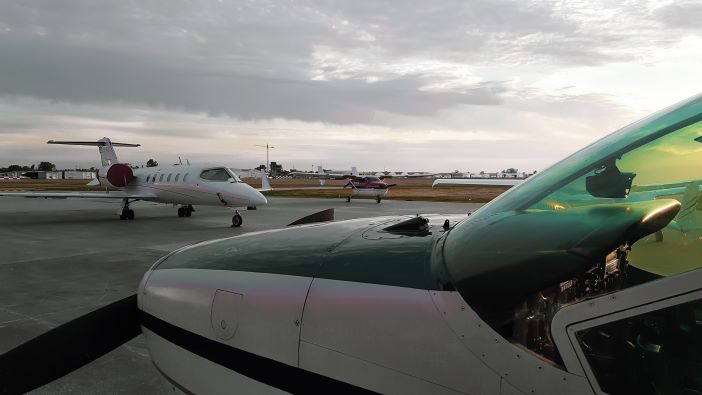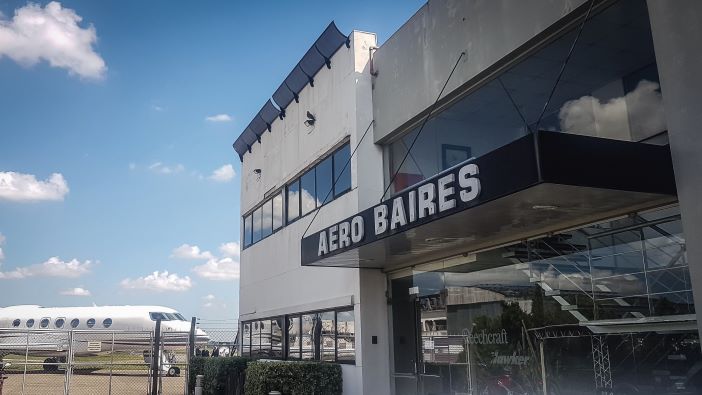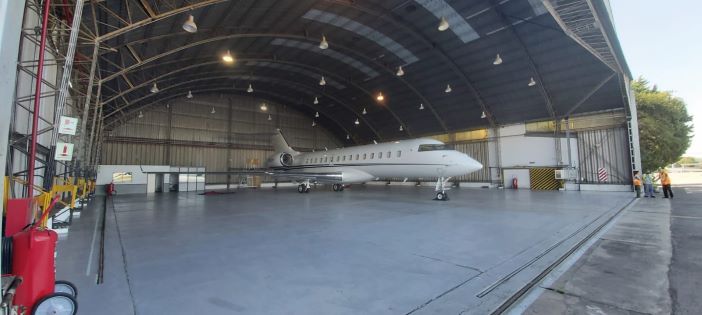Written by Pablo Diaz
Aviation is a cornerstone of modern transportation and has seen vast fluctuations across its different parts. In Argentina, executive and private aviation has witnessed some profound shifts during the recent unprecedented times.
Throughout the years executive aviation in Argentina has undergone many different phases. The private aviation sector was founded in the 1930s to change the overly centralized distribution of airliner routes to Buenos Aires. With government support, it grew into an extensive network of aerodromes and airports throughout the country that linked Argentina’s provinces with valuable flexibility.
The first business jets arrived in Argentina in the 1970s. A Hamburger Hansa HFB-320 with registration LV-JRH which flew for the state-owned energy company Gas del Estado had the honor of being the pioneer.
At that time, the center of private and business aviation was Don Torcuato International Airport. The airport was home to flight schools, hangars, MRO and charter service companies. Stimulated by tariff and exchange measures, companies renewed their fleets with business jets.
The complexity of local regulations favored aircraft operators that could handle air transport services, rather than keeping the fleets in-house. The coup de grâce for state-owned fleets was a wave of privatizations of government-owned companies in the early 1990s. YPF, Argentina’s national oil and gas company, operated 22 aircraft before dissolving its air division, in 1991.
Today, after several economic meltdowns, Don Torcuato Airport is just a memory. After its land was sold to real estate developers, most of its operations were moved to San Fernando International Airport, Argentina’s national nerve center of business aviation activity.
Covid-19’s impact
San Fernando International Airport witnessed a remarkable transformation during the pandemic. While commercial aviation operations saw a decline because of the multitude of restrictions imposed by Covid-19, executive aviation experienced a significant surge. Previously perceived as an exclusive domain for the elite, the pandemic demystified this branch of aviation for broader society.
Both corporations and individuals realized the accessibility of these flights, whether via the “empty leg” model, purchasing a single seat, or in its traditional form of renting an entire aircraft. This resulted in a significant uptick in executive flights compared to previous seasons.
According to statistics from the Agência Nacional de Aviação Civil (ANAC), the ratio between commercial operations and private flights was 16:42 in 2019. That number increased to 26:94 in 2020 and peaked in 2021 when it reached 32:59. As the world went gradually back to normal in 2022 the ratio lowered and now sits at 19:14 for the current year, but the trend is still going up.
International private travel also experienced a surge, not only in proportional numbers but also in absolute terms because commercial operations were significantly reduced. Those who needed to travel abroad found in private aviation a resource that was before the pandemic supposed to be unreachable to them.

of aircraft
MRO in Argentina
A significant piece of the support activities of the business / private ecosystem is based at San Fernando International Airport, just 28km (17 miles) outside Buenos Aires’ downtown. But executive aviation not only boasts a robust connectivity network but also an intricate framework of companies specializing in Maintenance, Repair, and Operation (MRO) services.
Argentina’s vast geographical spread and agro-industrial nature inherently requires a strong private aviation presence. Beyond the
30 concessioned airports of the National Airport System (SNA – Sistema Nacional de Aeropuertos), the segment graces over 400 aerodromes, aeroclubs, and heliports. This footprint outpaces by far the operations of commercial airlines in the country. Furthermore, there is an extensive network of representatives and maintenance centers for various aircraft manufacturers.
Hangar Uno, for instance, is not just the official representative for Argentina, Paraguay, and Uruguay for brands such as Piper, Robinson Helicopter, Kodiak, and HondaJet, but also plays a pivotal role in maintenance services. Aerotec stands out as a service center for Tecnam and Thrush.
Aviaser, on the other hand, offers a service center for big names like Textron Aviation, encompassing Cessna and Beechcraft. The latter is also being served by AeroRutas, which also supplies services for Bombardier and Falcon. Indaer has garnered recognition as a representative and service center for Pilatus. Cielo SA, in its stride represents and serves Cirrus Aircraft, a brand renowned for its innovative products.
Meanwhile, AeroBaires has carved out a reputation as the official representative and service center for Embraer, one of South America’s leading aviation brands. Lastly, Helicópteros Marinos takes the lead in servicing and representing Airbus Helicopters and Turbomeca. Each of these companies not only meets international service and maintenance standards but also contributes to making Argentina a focal point in executive aviation in the region. The technical quality of the staff and its advantageous exchange rate are key factors for owners and operators to perform maintenance tasks and training in the country.

Challenges and opportunities
While the executive aviation market in Argentina has managed to expand despite various economic and political upheavals, it is evident that challenges persist. These range from high tariffs and taxes to restrictions that impede operations, such as issues with foreign currency payments — a common hurdle for businesses in this sector. Such barriers can overshadow the broader economic benefits of aviation, including job creation across various domains like operations, engineering, maintenance, and administration.
Marcelo Paviotti, CEO of Cielo SA, the official representative of Cirrus Aircraft, said at the last AgroActiva trade fair that foreign currency access restrictions make it extremely difficult for operators to obtain spare parts and consumables, along with maintenance and aircraft conservation.
He is not the only one who faces these issues. In an economy that needs to hold on to each dollar, there are excruciating procedures to access funds. What is a challenge on one side is a fantastic opportunity for foreign customers, who can obtain proper services for a proper fee.
Consultancy is also on the rise in Argentina. TakeoffArg is a firm that provides a variety of services for anyone who wants to get things done without the hassle of taking care of the entire process.
“We work with air transportation companies, particular customers, clubs and everyone who needs assistance in Argentina and abroad, thanks to our international agreements,” says Florencia Canda, TakeoffArg’s CEO and Founder.
Economic instability could stall many crucial infrastructure projects. San Fernando is now handling operations that exceed its capacity, limiting its growth potential.
Meanwhile, Aeroparque Jorge Newbery in Buenos Aires is increasingly prioritizing commercial carriers over private operators.

Uncharted territory
The southern regions of Argentina present not only a need for connectivity but also a significant business opportunity in Patagonia. Affluent individuals from around the world have selected the picturesque landscapes of Patagonia and the Andes as their homes. Many have built private airfields on their properties or have enhanced the usage of existing public airports in various provinces.
Jalil Hamer Airport, situated just 7km (4 miles) from Perito Moreno in Santa Cruz province, exemplifies the growing national airport system’s drive to promote both commercial and private air travel. While mining activity currently supports regular flights from LADE (Líneas Aéreas del Estado – the Argentinian Air Force airline) recent infrastructural investments aim to adapt the airport for tourist charter services.
American Jet & Andes Líneas Aéreas
Two remarkable cases in Argentina’s aviation industry are American Jet and Andes. Both started operations providing charter services. American Jet, founded in 1984, found a niche linking mining and oil sites in Patagonia, but it also transports football teams, and business groups in non-regular operations.
In July 2019, the company announced that it would start flying regular commercial routes after incorporating two Embraer ERJ 145s. But then the pandemic hit. The company briefly flew a heavily subsidized route connecting La Rioja with Buenos Aires, but the plans for regular routes have since been abandoned.
Andes Lineas Aéreas climbed the hill a little higher, only for the fall to be much more brutal. The company started as a charter operator in 2006 and grew with some difficulties until 2016, when it decided to add four Boeing 737-800s to its fleet and start operating regular flights.
Andes almost reached the two million passengers carried mark in 2018, but an economic crisis – one of many – made it impossible for the airline to retain its leased fleet. A steep peso devaluation, a rise in oil prices, and the loss of a key contract to charter high school students to Bariloche was just too much for the company to continue operating.
With an aging fleet of four MD-83, it found itself with just two aircraft in very debatable flying condition and no funds. In 2023, the company resumed operations with another two Boeing 737s, but sticking to charter flights.
Looking ahead
The Argentinian aviation industry holds significant potential despite the country’s predicted 1.6% contraction in GDP for 2023 and a modest 1% recovery in 2024. The positive outlook persists despite regional economic volatility and infrastructural challenges.
Post-pandemic, Argentina has experienced a steady rise in aircraft imports for commercial and private. It is worth noting that each operational aircraft introduces both direct and indirect job opportunities, hinting at the immense potential for economic expansion.
While some view aviation merely as a luxury, the truth is it acts as a catalyst for economic growth and connectivity. Although Argentina grapples with infrastructural and resource issues, the nation’s deep well of knowledge and expertise in aviation cannot be overlooked.
Business and private aviation in Argentina has showcased robustness, adaptability, and a capacity for growth. With the right blend of policies, investments, and vision, the industry can elevate Argentina’s economic future and its position in global networks.
Ezeiza International FBO
Few places in Argentina are as exclusive as Ezeiza International Airport’s FBO, located just two miles apart from the commercial terminal and a luxurious point of entry for foreign private travelers.
Airport concessionaire Aeropuertos Argentina 2000’s division serves 150 flights – around 1000 passengers – monthly in its 20 positions, eleven contact stands, nine remote. The terminal was designed to meet VIP passengers’ most challenging demands. Javier Aquino, responsible for the facility says, “30% of our services are being provided to regional and international flights; the rest are domestic operations.

“We have two VIP rooms, for 10 and five passengers respectively. A hangar that can fit a Gulfstream 650, exclusive customs, border and security checkpoints and parking spaces. All that is offered at a competitive price.”





